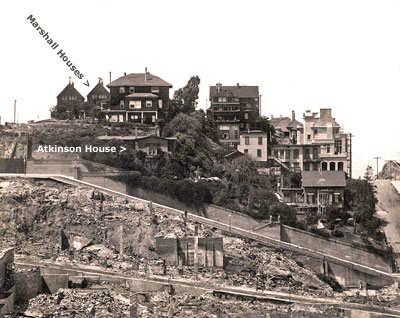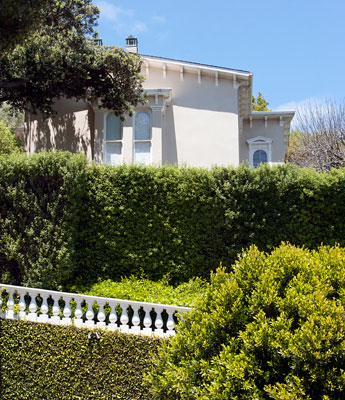San Francisco Landmarks
 Russian Hill after the 1906 Earthquake and Fire
Russian Hill after the 1906 Earthquake and Fire
Courtesy Bancroft Library, UC Berkeley
It is not clear when the great retaining wall along Broadway between Taylor and Jones first appeared, but it is believed that a developer, Joseph Britton, who graded off the top of Russian Hill and created lots along Broadway, had it built sometime after 1871 as it was not in photographs taken up until that time. The wall is amazingly sound and has moved very little; it still stands straight even though it survived the 1906 earthquake.
The buildings in this phorograph contribute to the Russian Hill Crest Historic District
(Click Photos to Zoom)
Atkinson-Escher House
1032 Broadway Between Jones and Taylor
Built 1853
The following is excerpted from the San Francisco Landmarks Preservation Advisory Board Final Case Report dated 19 January 1977:
Purported by many to be one of the oldest standing houses in San Francisco, this Italian Villa was built in 1853 by Joseph H. Atkinson, as his own home. It was remodeled around 1900 by Willis Polk.
Particularly in this area of the city, it is remarkable that the dwelling, located within walking distance of the original settlement at Yerba Buena Cove, has survived for 124 years.
An incised stone plaque above the front door reads:
EXCEPT THE LORD BUILD THE HOUSE
THEY LABOR IN VAIN THAT BUILD IT
EXCEPT THE LORD KEEP THE CITY
THE WATCHMAN WAKETH IN VAIN
MDCCCLIII
The house is seen in some of the earliest photographs of the city and from these it stands out as also one of the first houses on this portion of Russian Hill. In one photograph taken in 1867, it appears surrounded by a fence enclosing perhaps one-third of the block at Broadway and Jones Street. At that time Broadway from Mason to Jones Street was merely a "goat path" which zig-zagged up the hill. On Broadway just above Taylor was a natural spring where ferns and other greenery flourished. This spring is still evidenced today through leaks in the blacktop.
Atkinson was born in Pennsylvania. While in his middle thirties he arrived in San Francisco with his wife and young daughter sometime around 1850 during San Francisco's population boom. There is not much to be found on Atkinson himself, although the San Francisco Directory lists him as builder, bricklayer, real estate and patent agent, respectively from 1852 through 1871.
Photographs reveal that this house and others nearby withstood the earthquake and fire better than most and appeared untouched by either. According to Hilliam Bronson in The Earth Shook, The Sky Burned:
Partly through circumstances, partly by hard work and luck, these few homes were the only frame structures spared within the 490-block area.The owners of these few blocks had evaded the guards and remained behind to fight off the flames. Using water from cisterns that dated back to a day when the City's system didn't reach that far, the stubborn band fought for hours until dusk Friday. Buckets and brooms and wet towels were their tools. The men nailed wooden cleats to their roofs, to make it easier to reach trouble spots.
In 1916, Kate M. Atkinson sold the house to her two cousins, Jane and Florence Paul who ran a small school for local residents; Miss Atkinson continued to reside with them through 1919 when she is last listed at that address in the San Francisco Directory.
In 1931, a fire broke out in the house causing extensive damage to the upper floor areas. Today, charred beams can still be seen through a crawl space leading to a small attic. Bruce Porter, a well-known designer, was commissioned to repair the house.
The Paul sisters, elderly by this time, gave up their school. Jane Paul died in 1932 leaving the house to her sister. Florence Paul lived there until she died in 1940, at which time the house was sold to Katherine Po Littlefield and Walker Paul, a nephew. The house was rented to the Gunst family and sold again in 1946 to tugboat "king," Thomas Crowley who granted it to his daughter Virginia Crowley Escher; she and her family resided there until the fall of 1976. It was then purchased by Alan Nichols.
